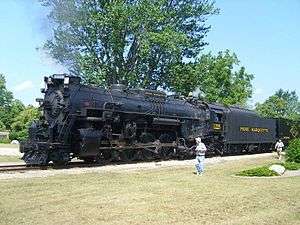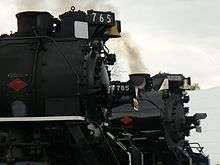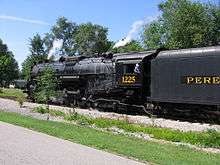Pere Marquette 1225
Pere Marquette 1225 is a 2-8-4 "Berkshire" type steam locomotive built in October 1941 for the Pere Marquette Railway (PM) by Lima Locomotive Works in Lima, Ohio. 1225 is one of two surviving Pere Marquette 2-8-4 locomotives, the other being 1223, which is on display at the Tri-Cities Historical Society near the ex-Grand Trunk Western (GTW) coaling tower, in Grand Haven, Michigan. It is perhaps most famous for serving as the basis for the locomotive in the 2004 film, The Polar Express.
| Pere Marquette 1225 | |||||||||||||||||||||||||||||||||||||||
|---|---|---|---|---|---|---|---|---|---|---|---|---|---|---|---|---|---|---|---|---|---|---|---|---|---|---|---|---|---|---|---|---|---|---|---|---|---|---|---|
 Pere Marquette 1225 in 2008 | |||||||||||||||||||||||||||||||||||||||
| |||||||||||||||||||||||||||||||||||||||
| |||||||||||||||||||||||||||||||||||||||
| |||||||||||||||||||||||||||||||||||||||
| |||||||||||||||||||||||||||||||||||||||
Pere Marquette Railway Steam Locomotive No. 1225 | |||||||||||||||||||||||||||||||||||||||
| NRHP reference No. | 94000744[1] | ||||||||||||||||||||||||||||||||||||||
| Added to NRHP | July 31, 1994 | ||||||||||||||||||||||||||||||||||||||
The Pere Marquette Railroad used 1225 in regular service from the locomotive's construction in 1941 until the railroad merged into Chesapeake and Ohio Railway (C&O) in 1947; it remained in use on C&O's Michigan lines until 1951. Slated for scrapping, 1225 was acquired by Michigan State University in 1957 and placed on static display.
In 1971, work began to restore 1225 to operational status, an effort that culminated in its first excursion run in 1988. The locomotive, listed on the National Register of Historic Places, is now used on excursion trains over the former Tuscola and Saginaw Bay Railway, now Great Lakes Central Railroad.
History
No. 1225 was built in 1941 by Lima Locomotive Works (LLW) for the Pere Marquette Railway (PM). PM ordered this type of locomotive in three batches from Lima: class N in 1937 (PM road numbers 1201–1215), class N-1 in 1941 (numbers 1216–1227) and class N-2 in 1944 (numbers 1228–1239). 1225 cost $200,000 to build in 1941 ($3,476,471 in current dollars). The build was complete on December 6, 1941, and delivered to the Pere Marquette.
The locomotives remained on the roster through the PM's merger into Chesapeake and Ohio Railway (C&O) in 1947; class N locomotives were renumbered to 2685–2699, class N-1 to 2650–2661, and class N-2 to 2670–2681. Part of the merger agreement, however, included the stipulation that locomotives that were acquired and fully paid for by PM would remain painted for PM after the merger. Although all the Berkshires received new numbers, only class N engines were repainted into standard C&O livery and renumbered. The majority of the class N locomotives were scrapped between 1954 and 1957, but class N-1s 1223 and 1225 were both preserved.
For the first part of its service life, 1225 was used to shuttle steel and wartime freight between Detroit, Saginaw, Flint and northern Indiana steel mills.
Retirement and restoration
Retired from service in 1951, 1225 was sent to scrap, in New Buffalo, Michigan. In 1955, Michigan State University Trustee, Forest Akers, the former VP of Dodge Motors, was asked by C&O Chairman Cyrus Eaton if the University would be interested in having a steam locomotive (Eaton did not want to scrap the engines but was having a hard time finding places that would accept them) so that engineering students would have a piece of real equipment to study. Forest Akers thought it was a good idea and proposed the idea to University President John Hannah. John Hannah accepted the gift of the locomotive. When he told the Dean of the College of Engineering about the gift, the Dean said that Engineering was not interested in an obsolete locomotive. John Hannah then called up Dr. Rollin Baker, director of the MSU Museum and told him that he was getting a locomotive.[2] The C&O then instructed the yardmaster at New Buffalo to send an engine to the Wyoming Shops for a cosmetic restoration and repainting with the name Chesapeake and Ohio on the side. Lighted number boards were added as was the standard for C&O engines, though the Pere Marquette Railway never used them. Eventually, the Michigan State Trust for Railway Preservation, operating at the Steam Railway Institute, decided to remove these. No. 1225 was the last engine in the line, i.e. easiest to get out.[3] It had nothing to do with the number representing Christmas Day. The Christmas Day myth seems to have arisen after the publication of the book, "Polar Express". Chris Van Allsburg took notice of the number.

Baker received the gift of the locomotive in 1957 when it was brought to campus. The locomotive remained on static display near Spartan Stadium on the Michigan State campus in East Lansing, Michigan for more than a decade. While on display, a child by the name of Chris Van Allsburg used to stop by the locomotive on football weekends, on his way to the game with his father. He later stated that the engine was the inspiration for the story, Polar Express.
During the time that Akers was alive, til 1966, money was allocated to paint and display the engine.[4] In 1969, a group of MSU students formed the Michigan State University Railroad Club as a railfan group. Steve Reeves, a student and part-time employee of the Museum, whose responsibility was to display the engine on football weekends, sent out a notice in the State News that the Railroad Club would be meeting. Those early meetings did not discuss the restoration of the engine. Instead, they were slide shows of engines various members had seen on trips across the US, most of which were diesels. In 1970, at the suggestion of Randy Paquette, the club investigated the possibility of restoring the locomotive to running condition and started on that goal in 1971, with Baker's permission. Baker later stated that he thought having students be occupied with restoring a locomotive was far more in keeping with his idea of the image the university should be presenting than campus protests. Dr. Breslin, the university vice president, was not so sure. After the club started removing the sheet metal and exposing a rusty boiler, Breslin sent Baker to the engine with two messages. The first was the instruction to paint the engine. (The university needs to look good, even when it is being worked on). The second message was the day the students stop working on the engine is the day the torches come out. The locomotive was safe as long as the students kept working on it. To emphasize, he had the hopper car next to the engine cut up the next week.
The students fired up the boiler in 1975 and blew the 1225's whistle for the first time in two decades. The MSU Railroad Club had looked to engine 1223 at the State Fairgrounds for parts. The Michigan Railroad Club, then custodians of that engine, objected, so needed parts were fabricated. As of 2016, 1223 is preserved in a lakeside park in Grand Haven, Michigan.
In 1977, Dr. Edgar Harden became the University Interim President. Chuck Julian, as President of the MSU Railroad Club, went to his reception and made an appointment to see him. Harden was asked about the engine's future. The Railroad Club had fired the engine and it was nearing operability. Harden said that the University was not interested in running a locomotive and if it was, it would be run by all university employees. He said that if the Railroad Club wanted to run the engine, it should form a 501(c)(3) corporation and then he would give the club the engine.
In that meeting, Dr. Harden told Chuck Julian that the University was closing the Shaw Lane Power Plant and planned to pull up the tracks. The railroad had informed the University that it did not want to maintain a switch on a line not being used. With no switch, there was no need to keep the track. If the Club wanted to be able to get the engine off the display track and onto the mainline, it needed to move it soon. Dr. Harden gave the MSURRC permission to connect the display track to the siding and move the engine over to a part of the track near the police station, with the provision that the club provide a bond, remove the fence, stairs and all of its belongings from the display site, then tear up the track put down along with the display track. The Club also had to repair the sidewalk that it needed to go through after it was done and generally clean up the site.
Colin Williams, of Williams Brothers Asphalt Paving Co. of Ionia, Michigan provided the Club with a surety bond, a dump truck, a front-end loader and a bulldozer plus operators to run the equipment which was used to build the grade. Club members then tore up the track next to the engine and laid it down behind the engine. The engine was then rolled down the tracks. Chuck Julian, Dave Jones, an equipment operator from Williams Brothers, Dick Grieves, and a group of Hmong refugees who volunteered their time, then spent the next three days with the Williams Brothers equipment restoring the site, including casting a new concrete sidewalk. Williams Brothers sent a grader from Ionia to fine grade the site after they were done with the bulk cleanup, including loading debris into the dump truck and rails onto a flatbed and hauling all of it to Ionia.
Dr. Harden said that if the Club could find another place on campus that was suitable, it could move the engine to it. He assigned Ted Simmons and the head of the Landscape Arts Department the task of working with Chuck Julian to find a place. They visited several places. Ted Simmons was not willing to give up a siding at Power Plant 65 for the engine. The Club would need to build one if it wanted one. The Club would not be able to build a cheap structure. If the Club or later the Trust wanted a structure, it would need to be built by contractors after the university approved the design.
This set Club members to looking for a new site. Several were looked at. The Ann Arbor Railroad had gone bankrupt at the time and the State of Michigan became the owner of its assets. Hank Londo spoke to his state Senator and arranged for the new Michigan State Trust for Railway Preservation (MSTRP) to lease the Owosso engine shop. The engine and all of its equipment were then moved there. This was a great place to move because the engine shop had a lot of equipment that would be useful in restoring the engine.
1988–present

The MSU Railroad Club and supporters of "Project 1225" formed the Michigan State Trust for Railway Preservation in 1978. Chuck Julian, then president of the MSU Railroad Club, became the Trust's first President. Soon after, the MSTRP was given ownership of 1225 by Michigan State University. The MSTRP moved 1225 to the former Ann Arbor Railroad steam backshop in Owosso in 1983.
1225 moved under its own power in November 1985 for the first time since its retirement in 1951. The first excursion service occurred in 1988 on a 17-mile trip between Owosso and St. Charles, Michigan. In August 1991, 1225 along with NKP 765 pulled a 31-car passenger train during the National Railway Historical Society's annual convention in Huntington, West Virginia.
The Trust started using the name, Steam Railroading Institute because it was thought that this name better represented the goals of the organization. The official name is still Michigan State Trust for Railway Preservation. The SRI name is registered as a DBA (Doing Business As), with the State of Michigan.
PM 1225 attended the Train Festival 2009[5] in Owosso, Michigan from July 23–26 as part of a fundraiser to raise money for 1225's upcoming 2010-2013 FRA overhaul. The national event showcased hundreds of train related items, events, and themes from around the country and some parts of the world. No. 1225 was not able to haul any excursions during the Festival due to 5 of its flues failing, which occurred on July 24. 1225 was on display during the rest of festival for people to visit the engine, chat with the crew, take photos, and explore the cab. On October 7, 2008, it was announced that NKP 765 would once again join 1225 at Train Festival, marking the first time the two Berk's have met each other since 1991. The famous Southern Pacific 4449 Daylight locomotive also attended the festival as one of the many attending engines along with the 1225 and 765. 1225 and 765 met up twice more that year, with a photo freight in August and an excursion in October.
The flue failing was later repeated on December 5 of that year, so in January 2010, 1225 went down for its required 15-year inspection, and it was found that the firebox sheets had deteriorated to the point of needing replacement. That program was largely completed through small and large donations of funds and labor by the organization's supporters. Approximately $900,000 had spent on 1225's FRA overhaul and on October 20, 2013. 1225 will run again for another 15 years until 2028 when its next overhaul work is due.
As of 2014, 1225 operates excursion trains over the Great Lakes Central Railroad (formally Tuscola and Saginaw Bay Railway) several times per year, including operations that leave Owosso and going to locations such as Alma, Clare, Mt. Pleasant, and Cadillac, Michigan. Since 2004, 1225 has hauled winter weekend excursions to Ashley, Michigan between Thanksgiving and the middle of December, due to copyright issues, as the "North Pole Express."
Influence on The Polar Express
In 2002, Warner Bros. was given copies of the 1225's blueprints, saved from oblivion and donated to the MSURRC by Hank Truer, which were the prototype for the locomotive image, and its sounds were used in the 2004 film The Polar Express. However, the whistle used in the film was provided by steam locomotive Sierra Railroad No. 3. The film was based on the Caldecott Medal winning book of the same name. The children's book was written and illustrated by Chris Van Allsburg, who grew up in Grand Rapids, Michigan, and as a child attended every home football game at Michigan State, next to which this engine was on static display. He recalls playing on this engine many times as a child saying, "I remember that train on campus,...I can't believe it's the same train! I climbed on that train. I actually stood on it."[6] Appropriately enough, the locomotive's road number is the date of Christmas, 12/25.
References
- "NPS Focus". National Register of Historic Places. National Park Service. Retrieved September 6, 2011.
- Personal The conversation between Dr. Baker and Chuck Julian
- Conversation between Chuck Julian, Railroad Club President, Sam Chidester, retired PM engineer, and Hershel Christiansen, retired roundhouse foreman. That was later confirmed to Chuck Julian by Henry (Hank) Truer, machinist at the PM.
- Personal Communication between Chuck Julian and Dr. Rollin Baker.
- http://www.trainfestival2009.com
- Detroit Free Press, Allsburg, November 4, 2004 "Meet Chris Van Allsburg"
- Edsen Breyer's Postcard Museum, Railroad Engines: Steam, part 3. Retrieved December 16, 2005.
- SteamLocomotive.com, Pere Marquette Berkshire Type Locomotives. Retrieved December 16, 2005.
- Lansing State Journal Historic locomotive is 'quite a show'. Retrieved January 4, 2006.
Further reading
- Gaffney, T.J.; Pyers, Dean (2014). Pere Marquette 1225. Images of Rail (1st ed.). Arcadia Publishing. ISBN 978-1-4671-1282-6.CS1 maint: ref=harv (link)
- Keefe, Kevin (2016). Twelve Twenty-Five: The Life and Times of a Steam Locomotive (1st ed.). Michigan State University Press. ISBN 978-1611862027.CS1 maint: ref=harv (link)
External links
| Wikimedia Commons has media related to Pere Marquette Railway 1225. |
- Steam Railroading Institute - current owners/operators of PM 1225.

